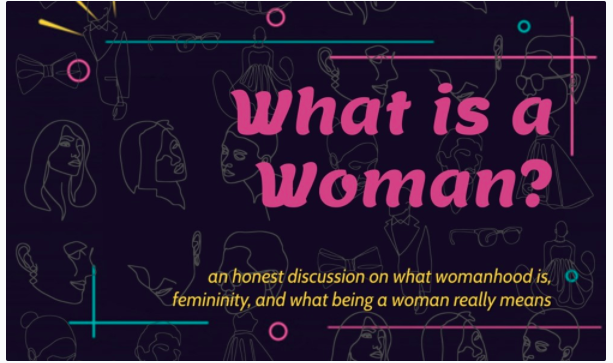
Rachel Dobkin, Staff Writer |
The Women and Gender Studies (WGS) Club and the Office of Equity and Inclusion hosted an event on Wednesday, Mar. 31, called “What is a Woman?” It prompted an honest discussion about the meaning of womanhood, femininity, and what it really means to be a woman.
The presenters started by saying that sex and gender are constructed binaries. In reality, there are far more than two sexes and two genders. The definitions and meanings of sex and gender have changed depending on time and location. They then identified the difference between the binaries. Sex is the categorization of people into male and female groups based on biological characteristics.
Gender is the cultural or social interpretation of sex and behavioral expectations associated with being a socially appropriate man or woman. It can also be seen as a performance and is something we do every day as a set of behaviors. It’s how we choose to present ourselves. Biology doesn’t equal gender, but we are socialized to perform masculinity or femininity depending on the gender imposed upon us at birth. The presenters said we must actively reject these constructive ideas. This will lead to a free society and the liberation of each and every one of us to be whomever we want to be.
The discussion then moved into gender norms. These are the rules placed on the performance of gender. They are socially and culturally embedded norms taught to us from the moment we become humans, and it is a vital way culture controls our behaviors and actions. Examples of feminine gender norms include having to be polite, containing yourself in a small physical space, hairlessness, skinny, and quiet.
The presenters went on to say that most of us inhibit femininity and masculinity in different ways at different times, and it means nothing about our gender identity or sexuality. It is simply about who we are and what makes us happy. At the end of the day, gender norms and expectations are socially constructed. There is no set way to perform any gender. We have the power to identify anywhere within the gender spectrum.
The discussion moved on to gender performance. Gender is performative, and we all perform gender differently. No one owes us a specific gender performance because of their gender identity. Nonbinary and gender-neutral people don’t need to be androgynous to be non-binary or gender nonconforming. Trying to push them into this is recreating more constrictive gender norms, which is really what they are rejecting. The bottom line is never to assume someone’s gender identity. If you are unsure of a person’s pronouns, use the pronouns they/them.
The presenters then talked a little about sexuality. Queer women and nonbinary folks are often invalidated for their sexual relationship if a man is not present. Queer women and nonbinary folks also often struggle to accept their queerness if they find themselves physically attracted to men but not sexually. This can lead to a constant feeling of discomfort and self-doubt. This enforces a strict sexual binary when in, reality, sexuality is fluid.
The presenters told the audience a famous quote used by many scholars to close the event, “Man and woman are at once empty and overflowing categories. Empty because they have no ultimate, metaphysical meaning. Overflowing because even when they appear to be fixed, they still contain within them an alternative, denied, or suppressed definitions.”
After the event, the WGS Secretary, Olivia Smith said, “I think that was a really important event to have. The concept of a woman is personal to everyone.” The WGS President, Sophia Monsalve, added, “At the end of the day, a woman is whoever says they are a woman.” An audience member, Michael Schneider ended things off by saying, “Being a woman has everything to do with what you feel and has nothing to do with what society feels.”
Leave a Reply